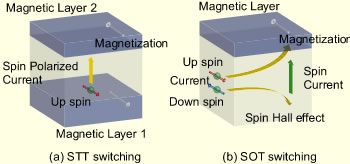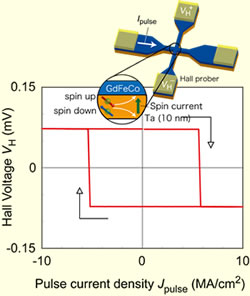![]()
Current induced magnetization switching (CIMS) has attracted considerable attention as a new technique for switching the magnetization in magnetic random access memories (MRAMs). Particularly, two types of current-induced magnetization switching are drawn significant attention, namely, spin transfer torque (STT) and spin orbit torque (SOT), which are schematically illustrated in Fig. 1. In STT switching, spin-polarized current is injected into magnetic layer, and angular momentum of the spin-polarized current is transferred to magnetization to reverse its orientation. In SOT switching, electric current is passed through heavy metal layer to produce spin current which is injected to reverse the magnetization. SOT switching is considered to be about 10 times faster than STT at same power consumption, and for SOT switching, electric current does not pass directly through magnetic layer during write operations; therefore, different current paths can be used for read and write resulting in low read disturb faults. |
Fig. 1 Schematics of (a) spin transfer torque (STT) switching and (b) spin orbit torque (SOT) switching.
Fig. 2 Spin orbit torque switching confirmed for the devices with GdFeCo (5 nm) layer. |


